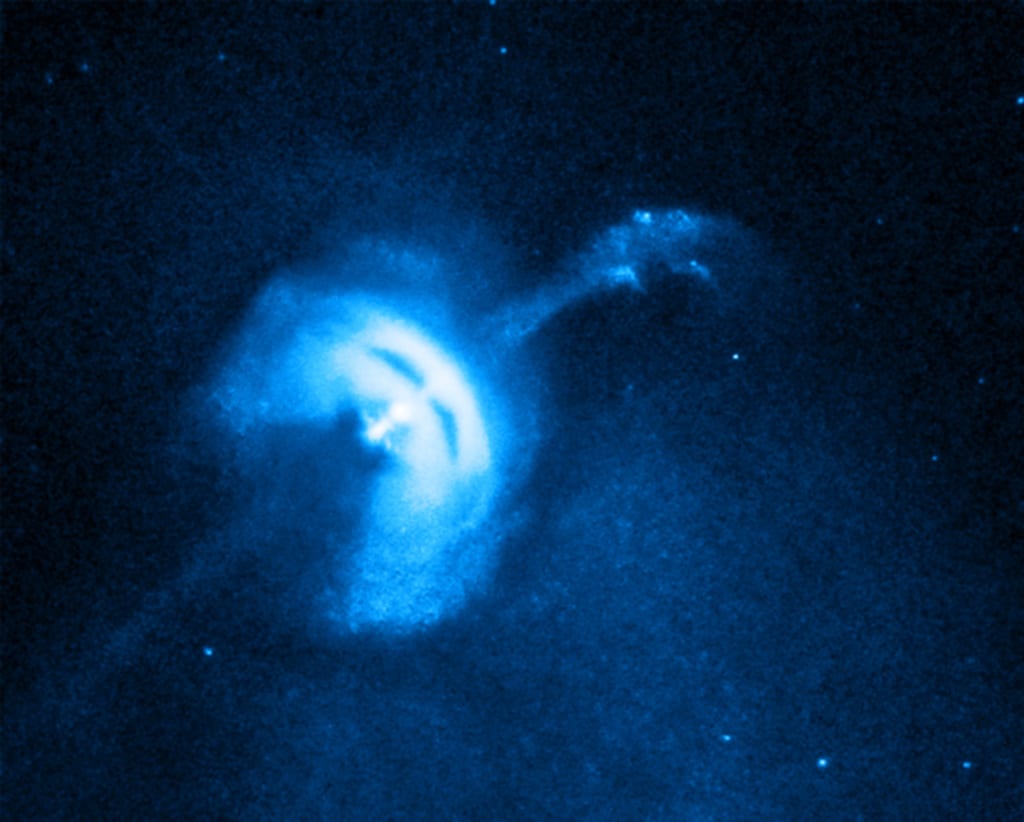
A pulsar is a highly magnetized, rotating neutron star that emits beams of electromagnetic radiation out of its magnetic poles. Neutron stars are extremely dense remnants of massive stars that have undergone a supernova explosion. When a massive star collapses under its own gravity, its core can form a neutron star, which is composed primarily of tightly packed neutrons.
As the neutron star rotates, it emits beams of electromagnetic radiation that can be observed as regular pulses of radiation if one of the beams points toward Earth. These beams are often emitted in the form of radio waves, but pulsars can also emit X-rays and gamma rays. The pulses from pulsars are extremely regular, with periods ranging from milliseconds to several seconds. The regularity of these pulses makes them easily detectable and distinguishable from other astronomical sources.
Pulsars were first discovered in 1967 by astronomers Jocelyn Bell Burnell and Antony Hewish. Since then, numerous pulsars have been observed and studied, providing valuable insights into the nature of neutron stars, gravity, and the behavior of matter under extreme conditions. Pulsars are also used as natural celestial clocks for various scientific studies, including testing theories of gravity, detecting gravitational waves, and studying the interstellar medium.Here are some additional details about pulsars:
Formation: Pulsars are formed during the supernova explosion of massive stars. When a star with several times the mass of our Sun exhausts its nuclear fuel, it undergoes a catastrophic collapse. The core of the star collapses under gravity, and if the remnant mass is between about 1.4 and 3 times the mass of the Sun, it becomes a neutron star. Pulsars are a type of neutron star that exhibits the unique property of emitting regular pulses of radiation.
Rotation and Magnetic Fields: Pulsars have extremely strong magnetic fields, typically billions of times stronger than Earth's magnetic field. As the neutron star rotates, its magnetic field becomes concentrated and generates powerful electric fields. Charged particles near the magnetic poles are accelerated along the magnetic field lines, producing beams of radiation that are emitted from the poles. These beams of radiation sweep across space like the beams of a lighthouse, leading to the observed pulsations.
Period and Spin Down: Pulsars have a characteristic period, which is the time it takes for the neutron star to complete one rotation on its axis. The period can range from a few milliseconds to several seconds. Over time, pulsars slow down due to the loss of rotational energy through the emission of radiation. This gradual slowing down is known as "spin down." By measuring the changing period of a pulsar, scientists can study its spin-down rate and gain insights into its age and energy loss mechanisms.
Types of Pulsars: There are several different types of pulsars, including radio pulsars (the most common type), X-ray pulsars, gamma-ray pulsars, and millisecond pulsars. Radio pulsars emit radio waves as their primary form of radiation, while X-ray and gamma-ray pulsars emit higher-energy photons. Millisecond pulsars are a special class of rapidly rotating pulsars with extremely short periods, often just a few milliseconds. These millisecond pulsars are believed to be "spun up" by the transfer of mass from a companion star in a binary system.
Pulsar Timing Arrays and Gravitational Waves: Pulsars can be used to detect gravitational waves, which are ripples in the fabric of spacetime caused by the acceleration of massive objects. Arrays of precisely-timed pulsars, known as pulsar timing arrays, can act as a galactic-scale detector of low-frequency gravitational waves. Gravitational waves passing through space cause slight perturbations in the arrival times of pulses from pulsars. By analyzing the timing data from multiple pulsars, scientists can search for these subtle signatures of gravitational waves.
Pulsars continue to be an exciting area of research in astrophysics, providing valuable insights into extreme physics, stellar evolution, and the nature of the universe.





Comments (1)
wow its amazing